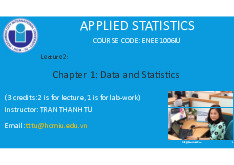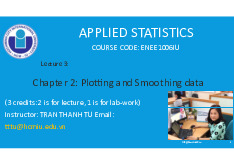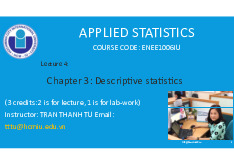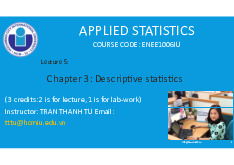



















Preview text:
lOMoAR cPSD| 45903860 APPLIED STATISTICS COURSE CODE: ENEE1006IU Lecture 9: Chapter 5: Hypothesis tests
(3 credits: 2 is for lecture, 1 is for lab-work) 1 lOMoAR cPSD| 45903860
5.1. HYPOTHESIS TESTING AND DECISION MAKING
•Developing null and alternative hypotheses •Type I and type II errors •Population mean: σ known
•Population mean: σ unknown •Population proportion
•Hypothesis testing and decision making
•Calculating the probability of type II errors 2 lOMoAR cPSD| 45903860
•Determining the sample size for a hypothesis test about a population mean
5.1. HYPOTHESIS TESTING AND DECISION MAKING
•A hypothesis is a statement or assertion about the state of nature
(about the true value of an unknown population parameter): The accused is innocent =100
•Every hypothesis implies its contradiction or alternative: The accused is guilty 100 3 lOMoAR cPSD| 45903860
•A hypothesis is either true or false, and you may fail to reject it or you
may reject it on the basis of information: Trial testimony and evidence Sample data
5.1. HYPOTHESIS TESTING AND DECISION MAKING
•Developing null and alternative hypotheses:
In hypothesis testing we begin by making a tentative assumption about a population
parameter. This tentative assumption is called the null hypothesis (H0)
We then define another hypothesis, called the alternative hypothesis (Ha), which is
the opposite of what is stated in the null hypothesis. 4 lOMoAR cPSD| 45903860
The hypothesis testing procedure uses data from a sample to test the two competing
statements indicated by H0 and Ha.
Care must be taken to •H0: µ =100 ; H0: µ > 100 structure the hypotheses Ha: µ ≠ 100; Ha: µ 100 appropriately so that the
hypothesis testing conclusion provides the information the researcher or decision • H0
and Ha are: maker wants.– Mutually exclusive Only one can be true. – Exhaustive
Together they cover all possibilities, so one or the other must be true.
5.1. HYPOTHESIS TESTING AND DECISION MAKING
•Developing null and alternative hypotheses:
The Alternative Hypothesis as a Research Hypothesis: 5 lOMoAR cPSD| 45903860
Before adopting something new, it is desirable to conduct research to
determine if there is statistical support for the conclusion that the new approach is indeed better.
In such cases, the research hypothesis is stated as the alternative hypothesis.
The alternative hypothesis is that the new method is better.
The null hypothesis is that the new method is no better than the old method.
5.1. HYPOTHESIS TESTING AND DECISION MAKING •Developing
null and alternative hypotheses:
The Null Hypothesis as an Assumption to Be Challenged:
Of course, not all hypothesis tests involve research hypotheses.
First, we consider applications of hypothesis testing where we begin with a
belief or an assumption that a statement about the value of a population parameter is true. 6 lOMoAR cPSD| 45903860
We will then use a hypothesis test to challenge the assumption and determine
if there is statistical evidence to conclude that the assumption is incorrect.
In these situations, it is helpful to develop the null hypothesis first.
The null hypothesis H0 expresses the belief or assumption about the value of the population parameter.
The alternative hypothesis Ha is that the belief or assumption is incorrect.
5.1. HYPOTHESIS TESTING AND DECISION MAKING
•Developing null and alternative hypotheses:
Summary of Forms for Null and Alternative Hypotheses:
•The hypothesis tests in this chapter involve two population parameters: the
population mean and the population proportion. 7 lOMoAR cPSD| 45903860
•Depending on the situation, hypothesis tests about a population parameter may
take one of three forms: two use inequalities in the null hypothesis; the third uses
an equality in the null hypothesis.
•For hypothesis tests involving a population mean, we let µ0 denote the
hypothesized value and we must choose one of the following three forms for the hypothesis test. Two- One-tailed tailed test test 5.1. HYPOTHESIS TESTING AND DECISION MAKING •Type I and type II errors:
•The null and alternative hypotheses are competing statements about the population. 8 lOMoAR cPSD| 45903860
•Either the null hypothesis H0 is true or the alternative hypothesis Ha is true, but not both.
•Ideally the hypothesis testing procedure should lead to the acceptance of H0 when
H0 is true and the rejection of H0 when Ha is true.
•Unfortunately, the correct conclusions are not always possible.
•Because hypothesis tests are based on sample information, we must allow for the possibility of errors.
5.1. HYPOTHESIS TESTING AND DECISION MAKING •Type I and type II errors:
By selecting α, a person is controlling the
probability of making a type I error: 9 lOMoAR cPSD| 45903860 -
If the cost of making a type I error is high,
small values of α are preferred. -
If the cost of making a type I error is not too high, larger values of α are typically used. The probability of making a type I error when the null hypothesis is true as an equality is called the level of significance.
Applications of hypothesis testing that only control for the type I error are called significance tests. 10 lOMoAR cPSD| 45903860
5.1. HYPOTHESIS TESTING AND DECISION MAKING •Population mean: σ-known:
•σ-known case: applications in which historical data and/or other information are
available that enable us to obtain a good estimate of the population standard deviation prior to sampling.
One-Tailed Test: One-tailed tests about a population mean take one of the following two forms:
For hypothesis tests about a population mean in the σ-known case, we use the
standard normal random variable z as a test statistic to determine whether
deviates from the hypothesized value of µ enough to justify rejecting the null hypothesis. 11 lOMoAR cPSD| 45903860
5.1. HYPOTHESIS TESTING AND DECISION MAKING •Population mean: σ-known: Test statistic z:
p-value approach: the p-value approach uses the value of the test statistic z
to compute a probability called a p-value.
A p-value is a probability that provides a measure of the evidence against
the null hypothesis provided by the sample.
Smaller p-values indicate more evidence against H0.
The p-value is used to determine whether the null hypothesis should be rejected. 12 lOMoAR cPSD| 45903860
(α: level of significant, common choices for α are 0.05 and 0.01)
5.1. HYPOTHESIS TESTING AND DECISION MAKING •Population mean: σ-known: Test statistic z:
Critical value approach: the critical value approach requires that we first
determine a value for the test statistic called the critical value.
For a lower tail test, the critical value serves as a benchmark for
determining whether the value of the test statistic z is small enough to reject the null hypothesis.
It is the value of the test statistic that corresponds to an area of α (the level
of significance) in the lower tail of the sampling distribution of the test statistic. 13 lOMoAR cPSD| 45903860
In other words, the critical value is the largest value of the test statistic z
that will result in the rejection of the null hypothesis.
5.1. HYPOTHESIS TESTING AND DECISION MAKING •Population mean: σ-known: Test statistic z:
For an upper tail test, using the critical value approach causes us to reject the
null hypothesis if the value of the test statistic is greater than 14 lOMoAR cPSD| 45903860
5.1. HYPOTHESIS TESTING AND DECISION MAKING •Population mean: σ-known: Two-Tailed Test: p-value approach: 15 lOMoAR cPSD| 45903860
Values of the test statistic in either tail provide evidence against the null hypothesis.
The p-value is the probability of obtaining a value for the test statistic as
unlikely as or more unlikely than that provided by the sample.
The computation of the p-value for a two-tailed test may seem a bit
confusing as compared to the computation of the p-value for a onetailed test. Critical value approach:
Critical values for the test will occur in both the lower and upper tails of the standard normal distribution.
5.1. HYPOTHESIS TESTING AND DECISION MAKING
•Population mean: σ-known: Summary 16 lOMoAR cPSD| 45903860 17 lOMoAR cPSD| 45903860
5.1. HYPOTHESIS TESTING AND DECISION MAKING 18 lOMoAR cPSD| 45903860
5.1. HYPOTHESIS TESTING AND DECISION MAKING 19 lOMoAR cPSD| 45903860 End of file 1. Any questions? tttu@hcmiu.edu.vn 18
5.1. HYPOTHESIS TESTING AND DECISION MAKING
•Population mean: σ-unknown:
σ-unknown case corresponds to situations in which an estimate of the
population standard deviation cannot be developed prior to sampling the sample
must be used to develop an estimate of both µ and σ.




